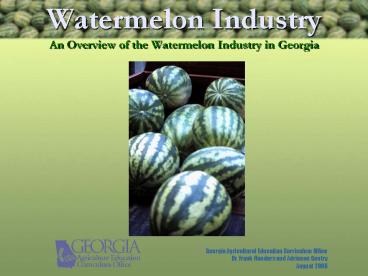Watermelon Industry An Overview of the Watermelon Industry in Georgia PowerPoint PPT Presentation
1 / 14
Title: Watermelon Industry An Overview of the Watermelon Industry in Georgia
1
Watermelon IndustryAn Overview of the Watermelon
Industry in Georgia
Georgia Agricultural Education Curriculum
Office Dr. Frank Flanders and Adrienne
Gentry August 2006
2
Objectives
- Students will be able to
- Outline the importance of the watermelon industry
in Georgia. - Name four watermelon varieties.
- Name the top three watermelon producing states.
- Discuss seedless watermelons.
- Rank the watermelon industry compared to other
Georgia agricultural commodities.
3
Why is the watermelon industry important?
Watermelons are delicious and nutritious and are
a summer tradition. By weight, watermelon is
the most-consumed melon in the U.S., followed by
cantaloupe and honeydew. Georgia ranks fourth
nationally in total value from watermelon
production.
4
Watermelon Products
- Simple slices
- Salsa
- Salad dressings
- Even muffins
- Used as decorations
5
Watermelon
- Watermelon's botanical name is Citrullus lanatus
of the botanical family Curcurbitaceae. It is a
cousin to cucumbers, pumpkins and squash. - Watermelons are "vine crops" with spreading
growth habits the crops of this family prefer hot
and humid weather as is found in the southern
United States. - Watermelons need an average of 4 months to
mature, from 80 to 120 days. A loose, sandy loam
soil is preferred. - The watermelon is comprised of about 90 water,
approximately 4 gallons for a forty pound melon.
Water supply is critical during the growth and
development of the plant and fruit. Water
shortages will cause noticeable gaps in
production with a reduction in leaf area and
overall yield.
6
Watermelon Varieties
- About 200-300 varieties are grown in the U.S. and
Mexico, although there are about 50 varieties
that are very popular. The following are the four
varieties you will most likely see at your local
store.
Picnic Crimson Sweet Jubilee Allsweet
SeedlessTriploid Hybrid
Mini-WatermelonYellow Flesh Red Flesh
Yellow Flesh Seeded Seedless
7
Seedless Watermelons
- How are seedless watermelons made? Where does a
plant without a seed come from? The answer is in
the number of chromosomes. A normal watermelon
plants chromosomes are doubled by the use of the
chemical colchicine. Doubling a normal (diploid)
watermelon results in a tetraploid plant (one
having four sets of chromosomes). When the
tetraploid plant is bred back, or pollinated, by
a diploid or normal plant, the resulting seed
produces a triploid plant. The seeds/plants have
three chromosomes and cannot reproduce. Seed of
seedless varieties are available from most major
seed companies.
8
Georgias Commodity Value
Item Rank by sale Sales (1000) Percent of total sales
Poultry and eggs 1 2,780,214 56.6
Vegetables, melons (watermelons), and potatoes 2 383,556 7.8
Cotton and cotton seed 3 318,013 6.5
Nursery, greenhouse, floriculture 4 315,324 6.4
Other crops and hay 5 246,936 5
Cattle and calves 6 240,070 4.9
Milk and other dairy products from cows 7 212,720 4.3
Fruits, tree nuts and berries 8 122,151 2.5
Grains, oilseeds, dry beans, and dry peas 9 102,464 2.1
Tobacco 10 89,058 1.8
9
US Watermelon Production
State Pounds Produced Acres
Harvested 1. Florida 800,000
25,000 2. California 688,500
13,500 3. Texas 605,000
27,500 4. Georgia 379,500
23,000 5. Arizona 294,400
6,400
10
Interesting Facts
- The first recorded watermelon harvest occurred
nearly 5,000 years ago in Egypt. - Over 1,200 varieties of watermelons are grown
worldwide in 96 countries. - Watermelon is about 90 water.
- Cordele, Georgia claims to be the "Watermelon
Capital of the World" because so many melons are
grown in the area and travel through the State
Farmers' Market there.
11
Interesting Facts
- Watermelon has no fat or cholesterol, is an
excellent source of vitamins A, B6 and C, and
contains fiber, potassium, lycopene. - Early explorers used watermelons as canteens.
12
Assessment
- 1. Name four watermelon varieties.
- 2. What is the scientific name for watermelons?
- 3. Name three of the top producing watermelon
states. - 4. How many varieties of watermelons are grown
in the United States and Mexico? - A. 1200-1300 B. 200-300 C. 500-600
D. 50-60 - 5. Georgia ranks __________ in the US in total
value from watermelon production. - A. First B. Tenth C. Fourth D.
Sixth - 6. What kind of weather do watermelons prefer?
- 7. How long do watermelons need to mature?
- 8. The watermelon is comprised of about
__________ percent water. - A. 15 B. 70 C. 60 D. 90
- 9. A shortage in what would be detrimental to a
watermelon crop? - 10. Where does watermelon production fall in the
Georgia commodity value list? - A. 2nd B. 7th C. 8th D. 3rd
13
Quiz Key
- 1. Picnic, Jubilee, Crimson Sweet, Allsweet,
Seedless, Triploid Hybrid, Ice Box, Yellow Flesh,
Mini-Watermelon, Red Flesh, Yellow Flesh. - 2. Citrullus lanatus
- 3. Texas, Arizona, Georgia, California, Florida
- 4. B. 200-300
- 5. C. Fourth
- 6. Hot and humid weather
- 7. Four months
- 8. D. 90
- 9. Water
- 10. A. 2nd
14
References
- http//www.watermelon.org/watermelon_funfacts.asp
- http//www.uga.edu/vegetable/watermelon.html

